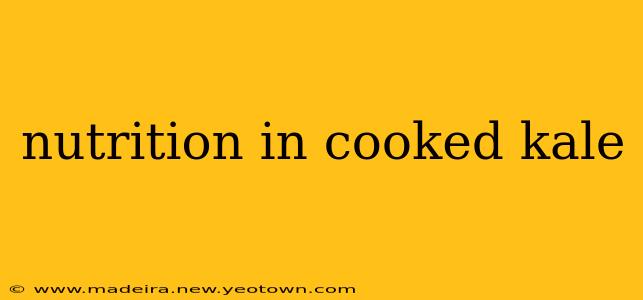Kale, that leafy green superhero of the vegetable world, boasts a nutrient profile that's hard to beat. But what happens to all that goodness when you cook it? Does cooking kale diminish its nutritional value, or does it actually unlock certain benefits? Let's embark on a culinary and nutritional journey to uncover the truth about cooked kale.
Our story begins in the garden, where vibrant kale leaves soak up the sun, diligently converting sunlight into a rich tapestry of vitamins, minerals, and antioxidants. This natural process creates a powerhouse of nutrition, but cooking methods can influence how much of these benefits we ultimately absorb. Fear not, kale enthusiasts! Cooking kale doesn't automatically mean sacrificing nutrition; it simply means understanding the nuances and choosing the right approach.
How Does Cooking Affect Kale's Nutritional Value?
This is the million-dollar question, isn't it? The truth is, cooking kale does change its nutritional composition, but not necessarily for the worse. Some nutrients are more sensitive to heat than others. For example, vitamin C, a water-soluble vitamin, is more susceptible to leaching during cooking, particularly if boiled in large amounts of water.
However, cooking kale can also enhance the bioavailability of certain nutrients. This means that cooking can make some nutrients easier for our bodies to absorb. For instance, some studies suggest that cooking kale can improve the absorption of carotenoids, powerful antioxidants responsible for kale's vibrant green color and associated health benefits.
What are the Best Ways to Cook Kale to Preserve Nutrients?
The key is to minimize nutrient loss and maximize bioavailability. Steaming, sautéing, and stir-frying are generally considered the best methods for cooking kale while retaining most of its nutritional value. Let's explore each method in detail:
Steaming: This gentle method preserves the most nutrients, as it doesn't involve adding water that could leach out vitamins. Simply steam until tender-crisp, avoiding overcooking.
Sautéing: Sautéing in a little olive oil or other healthy fat not only adds flavor but also helps the body absorb fat-soluble vitamins like vitamin A and K. Be mindful of cooking time to prevent burning.
Stir-frying: Similar to sautéing, stir-frying is a quick method that helps retain nutrients. The quick cooking time prevents excessive nutrient loss.
Boiling: Boiling kale is generally the least recommended method, as it involves prolonged exposure to water, which can lead to significant vitamin leaching. If you must boil kale, minimize cooking time and use the cooking water (rich in nutrients) in soups or sauces.
What Nutrients Does Cooked Kale Contain?
Cooked kale remains a nutritional powerhouse. While some nutrient levels might decrease slightly depending on the cooking method, you'll still get significant amounts of:
- Vitamin K: Crucial for blood clotting and bone health.
- Vitamin A: Important for vision, immune function, and cell growth.
- Vitamin C: A powerful antioxidant that supports the immune system.
- Calcium: Essential for strong bones and teeth.
- Potassium: Important for maintaining healthy blood pressure.
- Fiber: Promotes digestive health and keeps you feeling full.
Does Cooking Kale Make it Easier to Digest?
Yes, cooking kale does tend to make it easier to digest for many people. Raw kale contains compounds that can be difficult for some digestive systems to break down. Cooking softens the fibers, making it more gentle on the stomach.
How Can I Maximize the Nutritional Benefits of Cooked Kale?
Here are some tips to get the most out of your cooked kale:
- Don't overcook it: Aim for tender-crisp kale; overcooked kale can become mushy and less palatable.
- Use healthy fats: Adding a little olive oil or other healthy fats during cooking enhances the absorption of fat-soluble vitamins.
- Combine with other nutrient-rich foods: Kale pairs well with other vegetables, legumes, and grains, creating a balanced and nutritious meal.
- Consider adding spices: Spices can add flavor and potentially boost the antioxidant content of your meal.
In conclusion, cooking kale doesn't negate its nutritional value. By using appropriate cooking methods and understanding the nuances of nutrient retention, you can continue to enjoy this leafy green's amazing health benefits. So, go ahead and add some cooked kale to your diet – your body will thank you for it!

